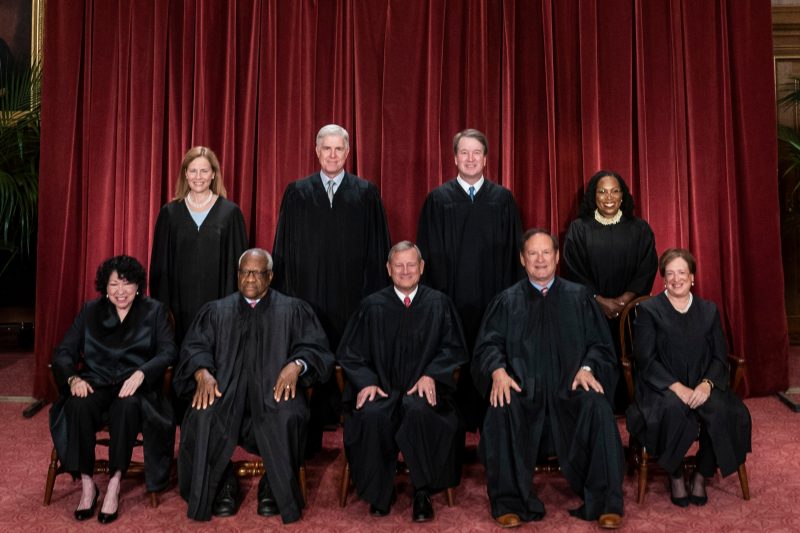A central challenge for perceptions of the legitimacy of the Supreme Court was distilled succinctly by the New York Times.
“The ethical conduct of the Supreme Court has been under growing scrutiny,” Emmarie Huetteman wrote. “Questions have been raised over Justice Clarence Thomas’s appearances before Republican-backed groups and his acceptance of favors from a contributor in Texas, Harlan Crow, as well as over his wife, Virginia Thomas, and her job as a conservative advocate.”
Huetteman hasn’t worked for the Times since 2017. So how’d she capture the current gestalt so accurately? Because it hasn’t changed since 2011, when she wrote the passage above.
Writer Tom Scocca unearthed that snippet as he was recently exploring Chief Justice John G. Roberts Jr.’s declination of a summons from the Senate Judiciary Committee. Huetteman’s 2011 article focused on an appearance by Justices Stephen G. Breyer and Antonin Scalia before that same committee. Breyer and Scalia no longer serve on the court and, for its part, the court no longer seems particularly interested in being grilled by the Senate.
Retired conservative judge J. Michael Luttig — best known of late for sounding the alarm about Donald Trump’s efforts to overturn the 2020 election — offered thoughts to the Judiciary Committee in advance of a hearing on Tuesday that speak directly to this shift in approach from the court.
“The only power the Supreme Court has is its mere judgment, and at that, it must depend for the efficacy of that mere judgment upon the respect and good faith of the Executive and the Executive’s power to execute the laws. The Supreme Court depends upon the respect and good faith of the Congress of the United States, as well,” Luttig wrote. “… [T]he Supreme Court’s power is greater or lesser as respect for its judgments by the American People waxes and wanes, ebbs and flows.”
As such, he wrote:
If the court needs the respect of the American people to wield its power, it’s been on shaky terrain since at least 2005. That was the point at which confidence in the Supreme Court fell and remained beneath 50 percent in Gallup polling. From 1990 to 2004, the percentage of Americans expressing a “great deal” or “quite a lot” of confidence in the court averaged 46 percent. From 2005 to 2022, the most recent year for which data is available, the average has been 36 percent. In 2022, the figure was the lowest on record: 25 percent.
In part, that’s because of the collapse of confidence among Democrats that accompanied the overturning of Roe v. Wade. Views of the Supreme Court have generally fallen into the same pattern as views of the other branches of government: When liberal justices hold a majority, Republican confidence wanes; when conservative justices do, Democrats are more skeptical. According to Gallup, partisan views of the court flipped in 2018, after the appointment of Justice Neil M. Gorsuch and soon before the fight over Justice Brett M. Kavanaugh’s nomination.
That nomination fight is itself a reflection of how partisanship colors the court in a way it didn’t used to. As The Washington Post reported last year, confirmation of justices to the court has gone through three phases over time: approval by voice vote, near-unanimous approval by recorded vote and, most recently, approval by narrow, partisan margins.
In the past two decades — the decades that brought us most of the current court — it’s that third avenue that’s been the norm.
The Kavanaugh fight was particularly bruising, involving accusations dismissed out of hand by his conservative supporters and neutralized by an investigatory process that did little to quell skepticism. It harked back, in tenor and tone, to the fight over the nomination of Clarence Thomas in 1991 — a bruising fight in an era where that wasn’t the norm.
Last month, ProPublica drew new attention to Thomas’s acceptance of expensive gifts from Harlan Crow, the conservative billionaire mentioned by Huetteman back in 2011. That was followed by a report scrutinizing a property sale benefiting Gorsuch, a look at consulting fees earned by Roberts’s wife, and renewed scrutiny of disclosed and undisclosed payments made to liberal justices such as Sonia Sotomayor.
The renewed focus on Thomas and the debate over implementing ethics rules for the court has been framed by some on the right as being itself political. Now, after all this time, the media is hyperactively focused on the court? Surely this is a function of the left’s frustration at the conservative majority — and, perhaps, a vehicle for effecting some overhaul of the court or its power.
It’s worth noting that the amount of attention being paid to the court is high but not unprecedented. Through April, the three largest cable-news channels — CNN, Fox News and MSNBC — mentioned the Supreme Court about 9,600 times, more than any year from 2010 to 2016, though only barely more than 2016. (Scalia died that February.) It’s lower than both 2017 and 2022, when new justices were confirmed to the bench.
It’s also worth noting that there’s an obvious outlier in Supreme Court attention. Usually, justices see spikes in mentions on cable news in the years they are retiring or confirmed to the bench. (Those years adjoin the gray sections on the charts below.) Justice Samuel A. Alito Jr. got a lot of attention last year, as the author of the leaked opinion overturning Roe.
The outlier, though, is Thomas. MSNBC mentioned Thomas more than 2,000 times last year, certainly itself a function of partisanship. But he was also mentioned twice as often on CNN and Fox News combined as was Alito. And that was before the new attention on his relationship with Crow.
A key reason Thomas was in the news in 2022: his wife. Ginni Thomas (as she’s known) was tied to efforts to overturn the 2020 election, drawing new attention to her right-wing activism and her relationship with her husband.
Again, Huetteman was writing about these exact same issues with Thomas in 2011. She was offering them as examples of the “growing scrutiny” the court’s ethical conduct was generating. And, quite obviously, nothing was done to ameliorate those concerns.
The court’s respect problem, then, is twofold. First, Thomas continues to draw unfavorable attention to the court in consistent ways. Second, partisanship colors perceptions of respectability, so that conservatives are more likely to excuse or rationalize Thomas’s behavior (as many were with Trump) and liberals more likely to criticize it.
The good news for the court is that the first issue is addressable, at least in theory: Implement a code of conduct, and see Thomas and others sever ties with benefactors (or at least demonstrate more rigor about reporting and recusing).
That second issue, partisanship, may not be. Liberal confidence in the court plunged not because of what its members were doing outside the chamber but inside of it. Even were Thomas’s wife not a conservative activist and his financial ties unassailable, that the court is deciding the way it does disinclines many on the left to consider it legitimate, just as Republicans were long skeptical of its more-liberal decisions. That the conservative majority is a function of the Trump presidency and the machinations that left a seat open for Gorsuch only exacerbate left-wing frustration.
In other words, the court’s issues may not be fixable. Like the presidency and Congress, it may be indelibly stained with the muck of partisanship.
Luttig’s advice may be for naught.








